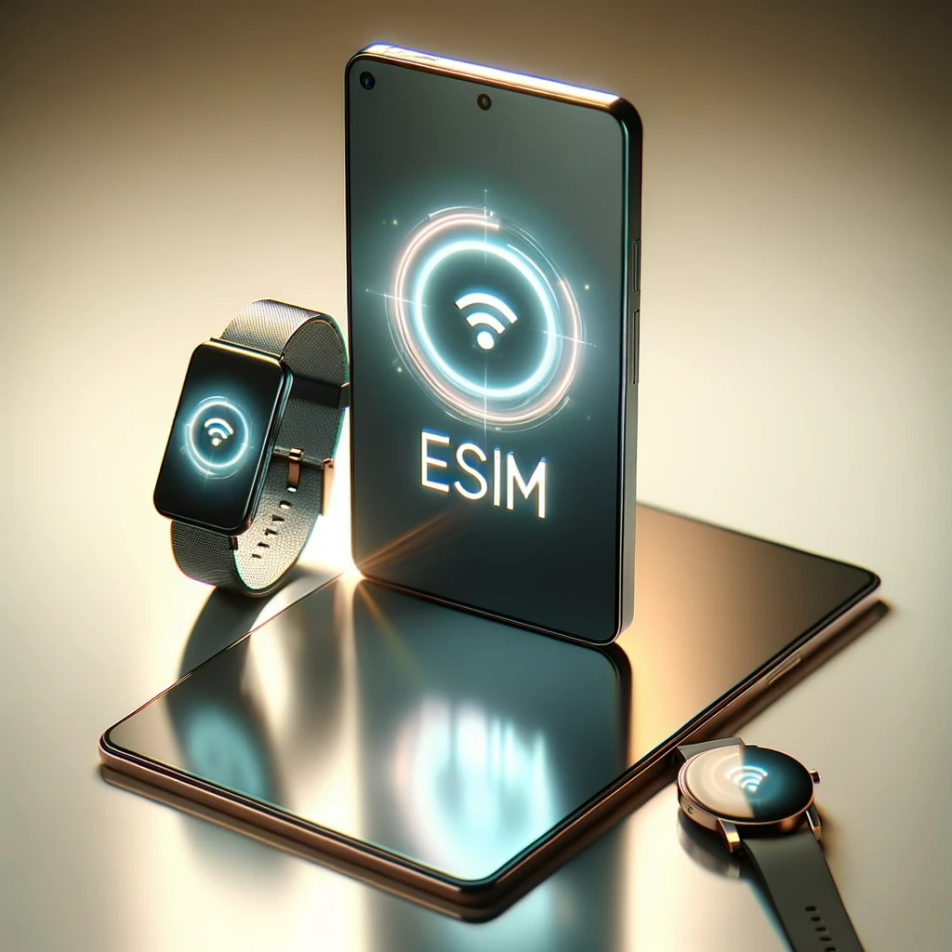How to Check My Phone Support eSIM?
Nov 18,2023 | wilming
An eSIM, or Embedded SIM, represents a significant advancement in SIM card technology. Unlike traditional SIM cards, an eSIM is built directly into your device. It's a small chip that serves the same purpose as a conventional SIM card, but without the physical swapping. eSIM card offer greater flexibility, allowing users to switch carriers or plans without needing a new SIM card.
Checking if your device supports eSIM is crucial for several reasons. Firstly, it determines whether you can enjoy the convenience and flexibility that eSIMs offer, such as easy switching between carriers and plans. Secondly, for travelers, an eSIM-compatible device means being able to connect to local networks without the hassle of physical SIM cards. Lastly, understanding your device's compatibility is essential for future-proofing your connectivity needs.
Does Your Phone Supports eSIM

In today's rapidly evolving digital landscape, the shift from traditional SIM cards to embedded SIMs (eSIMs) is a significant leap. This technology not only simplifies device setup by eliminating the need for physical SIM cards but also offers enhanced flexibility for managing multiple network providers. However, the key to harnessing these benefits lies in determining whether your phone is eSIM-compatible. Let's explore how you can check this for some of the most popular smartphone brands.
Identifying eSIM Compatibility in Popular Phone Models
As the telecommunications industry evolves, various smartphone manufacturers are integrating eSIM technology into their devices. This shift not only signifies a move towards more advanced technology but also caters to the growing demand for flexibility and ease in managing mobile services. Let's delve into the eSIM compatibility across different popular brands, including Apple, Samsung, Google, Huawei, and others, to see how each is adapting to this innovation.
Apple
Apple's journey with eSIM technology began with the iPhone XS, XS Max, and XR. Since then, Apple has consistently incorporated eSIM across its newer models. The latest iPhones, including the iPhone 14 series, offer a dual-SIM option, combining a physical SIM slot with an eSIM. This integration signifies a move towards more adaptable and user-friendly mobile experiences.
Samsung
Samsung has been progressively integrating eSIM into its smartphone lineup, starting with the Galaxy S20 series. This feature is also available in the newer S22 series, as well as in the innovative Galaxy Z Flip and Fold series. Samsung's adoption of eSIM technology reflects its commitment to providing cutting-edge and versatile solutions to its users.
Google has been a strong proponent of eSIM technology, beginning with the Pixel 2. The company has maintained this trend in subsequent releases, including the Pixel 4, 4a, 5, 6, and the latest Pixel 7 series. Google's consistent support for eSIM highlights its dedication to enhancing user connectivity and convenience.
Huawei
Huawei has embraced eSIM technology in several of its models, such as the P40, P40 Pro, and the Mate 40 series. By incorporating eSIM, Huawei is paving the way for a future where the traditional physical SIM cards are no longer the norm, focusing instead on a more integrated and seamless user experience.
Oppo
Oppo, known for its innovative smartphone designs, has embraced eSIM technology in select models. The Oppo Find X3 Pro is a prime example, featuring eSIM support alongside cutting-edge features. This move by Oppo not only enhances user convenience but also positions the brand as a forward-thinking player in the smartphone market.
Locating the eSIM Option in Your Phone's Settings
Finding the eSIM settings on your smartphone is crucial for activating and managing your eSIM profiles. Here are detailed steps for various operating systems to help you locate the eSIM option:
For iPhones
- Open Settings: Tap on the 'Settings' app on your iPhone.
- Access Cellular Settings: Scroll down and select 'Cellular' or 'Mobile Data' depending on your region.
- eSIM Setup: If your iPhone is eSIM compatible, you'll see an option to "Add Cellular Plan." Tapping this allows you to scan a QR code provided by your carrier or enter details manually to set up your eSIM.
For Android Phones
- Open Settings: Go to the 'Settings' app on your Android device.
- Navigate to Network Settings: Select 'Network & Internet' followed by 'Mobile Network'.
- eSIM Management: If your phone supports eSIM, you'll find an option such as "Add eSIM" or "eSIM profiles." Here, you can add or manage your eSIM settings.
For Specific Brands
- Samsung: Look under 'Connections' in the Settings menu.
- Google Pixel: Go to 'Network & Internet' and then 'Mobile Network' to find eSIM settings.
- Huawei: Check under 'Wireless & Networks' or similar categories.
Each phone might have slightly different paths to these settings, and the terminology may vary. If you're unable to locate the eSIM settings, refer to your device's user manual or contact the manufacturer's customer support for guidance.
Does Your Carrier Supports eSIM

While having an eSIM-compatible phone is one part of the equation, the ability to use eSIM card also hinges on whether your mobile carrier supports it. Carrier support for eSIM is growing, but it's not universal yet. Knowing if your carrier provides eSIM services is essential for activating and using it effectively. This section will guide you through the steps to determine if your carrier supports eSIM and how to access their services.
How to Determine if Your Carrier Supports eSim
Here are ways on determining if your carrier supports eSim:
Researching Carrier Support
To determine if your mobile operator supports eSIM, begin by exploring their official stance on this technology. As eSIM gains traction, an increasing number of carriers are beginning to offer it, though its availability might differ depending on your geographical location and the specific mobile plan you have. The most reliable way to get this information is by visiting your carrier's website or getting in touch with their customer service. They can provide the latest updates and specific details about eSIM compatibility and activation procedures.
Visiting the Official Website
Most carriers provide detailed information about their eSIM support and activation process on their official websites. Look for sections like “Help,” “Support,” or “FAQs” for eSIM-related information. This can often be the quickest way to get reliable and up-to-date details.
Contacting Customer Service
If the website doesn't provide clear information, or if you have specific questions, reaching out to customer service can be helpful. They can offer personalized assistance and guide you through the process of eSIM activation, if available.
Remember, while eSIM offers a level of convenience and flexibility, its implementation and support can vary significantly between different carriers and regions.
Can eSIM be Used Internationally

One of the most appealing features of eSIM technology is its potential for international use. eSIMs can indeed be used internationally, offering a more convenient and often cost-effective alternative to traditional SIM cards for travelers.
Advantages of Using eSim to International Travelers
Here are the advantages of using eSIM for international travel:
Ease of Switching Carriers
With an eSIM, you can switch to a local carrier's plan without the need to physically purchase and insert a new SIM card. This can be done prior to your travel or upon arrival, depending on the carrier's offerings and your device's capabilities.
Avoiding Roaming Charges
Using an eSIM can help avoid hefty roaming charges typically associated with international travel. By subscribing to a local data plan in the country you're visiting, you can enjoy local rates for calls, texts, and data usage.
Multiple Plans on One Device
eSIMs allow you to have multiple plans stored on your device. This means you can keep your home country's SIM active for calls and texts while using a local eSIM plan for data, ensuring you're always connected.
Considerations for Using eSIM Internationally
Consider the following when using eSim internationally:
Carrier Compatibility
Before traveling, check if your home carrier's eSIM can be used internationally or if you need to subscribe to a local eSIM plan upon arrival. Not all carriers support international eSIM use, so it's important to verify this in advance.
Device Support
Ensure your device supports eSIM and is unlocked if you plan to use a local carrier's eSIM service. Some devices might be locked to a specific carrier or not support eSIM technology at all.
Plan Availability
Research the availability of eSIM plans in your destination country. Some countries have a wide range of eSIM options for travelers, while others might have limited choices.
Using an eSIM can significantly simplify staying connected while traveling abroad. However, it's crucial to do your homework regarding carrier policies, device compatibility, and plan availability to make the most out of this technology.
FAQ About eSIM
eSIM technology, while increasingly popular, can raise questions for those new to it or considering making the switch from traditional SIM cards. Here are some frequently asked questions about eSIMs to help clarify common queries and concerns.
What is an eSIM?
An eSIM (Embedded Subscriber Identity Module) is a digital SIM that allows you to activate a cellular plan from your carrier without the need for a physical nano-SIM. It's soldered directly onto your device's motherboard.
How do I set up my eSIM?
Setting up an eSIM typically involves scanning a QR code provided by your carrier or manually entering plan details into your device's cellular settings. The exact steps can vary based on your device and carrier.
Can I use my eSIM on multiple devices?
No, eSIMs are generally locked to a single device and can't be transferred like physical SIM cards. However, you can have multiple eSIM profiles on a single device.
Is eSIM better than a physical SIM?
eSIM offers several advantages over physical SIM cards, such as the ability to switch carriers without changing SIM cards, storing multiple plans on one device, and enhanced security. However, whether it's "better" can depend on your specific needs and usage.
Can I switch back to a physical SIM after using an eSIM?
Yes, you can switch back to a physical SIM card at any time. Your device can store eSIM profiles even while you're using a physical SIM card.
Do all carriers support eSIM?
Not all carriers currently support eSIM, and availability can vary by region and carrier. It's important to check with your specific carrier for eSIM support.
Is eSIM secure?
Yes, eSIMs are considered secure. They offer the same security levels as physical SIM cards and are less prone to physical theft or loss.



